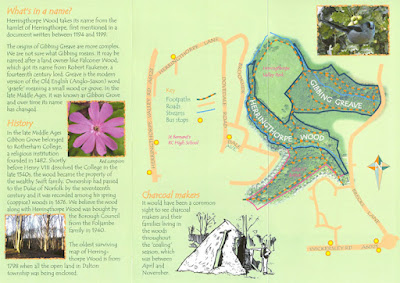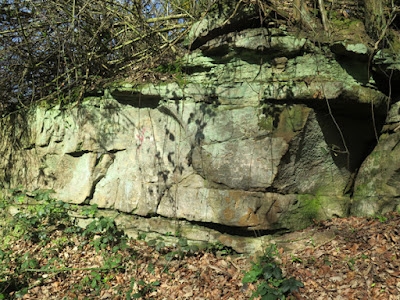 |
| Exposures of sandstone at Great Bank Quarry |
Having completed the first leg of my investigation of the Pennine Upper Coal Measures Formation (PUCMF) in Rotherham, at Listerdale and Brecks Woods, I made my way up to the path that would take me to Gibbing Greave – a small area of woodland that I had discovered, along with Herringthorpe Wood, on the Casual Ramblers website.
Apart from the fact that both woods have streams running through them, which might expose some mudstones and siltstones, these were green spaces in Rotherham that I had not visited and at the southern end of the Herringthorpe Wood was the disused Great Bank Quarry, which I had visited briefly in 2017 with a few members of SAGT (Sheffield Area Geology Trust).
Entering Gibbing Greave, it took less than 15 minutes to complete my investigation of the stream banks, with the only points of interest being further examples of head and the development of a spring on the south side of the stream, whose flow had exposed isolated patches of flaggy sandstone at the junction with the stream.
Leaving the wood, I stopped for a few minutes to take in the panoramic views to the north and north-west of Rotherham, with Hoober Stand – one of the Wentworth follies – just visible in the distance, standing on a ridge of Abdy Rock.
Continuing to Herringthorpe Wood, I didn’t notice anything of particular geological interest and, stopping only to photograph a large bumblebee that had caught my eye, I hurried on until I reached Great Bank Quarry.
The quarry is one of the RIGS (Regionally Important Geological Sites) in Rotherham that I did not visit myself and, at the time of the survey in 1989, the British Geological Survey placed it on the Dalton Rock. The 1957 memoir describes it as “yellow, medium-grained sandstone with micaceous and carbonaceous partings and with plant debris”; however, on the latest edition of the map, it is now marked as an unnamed sandstone in the PUCMF.
On the north side of the quarry, there is a good example of massive sandstone with large scale cross-bedding, which passes upwards into flaggy beds – as can also be observed in several exposures at the old quarries in Canklow Wood.
On the west side, although some of the rock face has been blackened with fires created by youths that are attracted to old quarries like this, various other interesting sedimentary structures can still be quite clearly seen.
I don’t know anything about the history of this quarry, but the differential weathering of the soft siltstone and mudstone has highlighted the limitations of this stone for use as a building stone – and I can imagine that this sandstone has only been used locally as a general walling stone.
Looking closely, the carbonaceous beds described in the memoir are quite obvious, although I didn’t seen any plant material. On the right hand side of the quarry, where I collected a couple of samples, there are high levels of iron in the medium/coarse grained sandstone – with a general staining of the rock and the development of thin bands of dense ironstone.
I also collected a couple of samples from one of the banks of discarded material that lie at the entrance to the quarry. These are light brown in colour, with some light iron banding and are much finer grained and flaggy in nature.











No comments:
Post a Comment